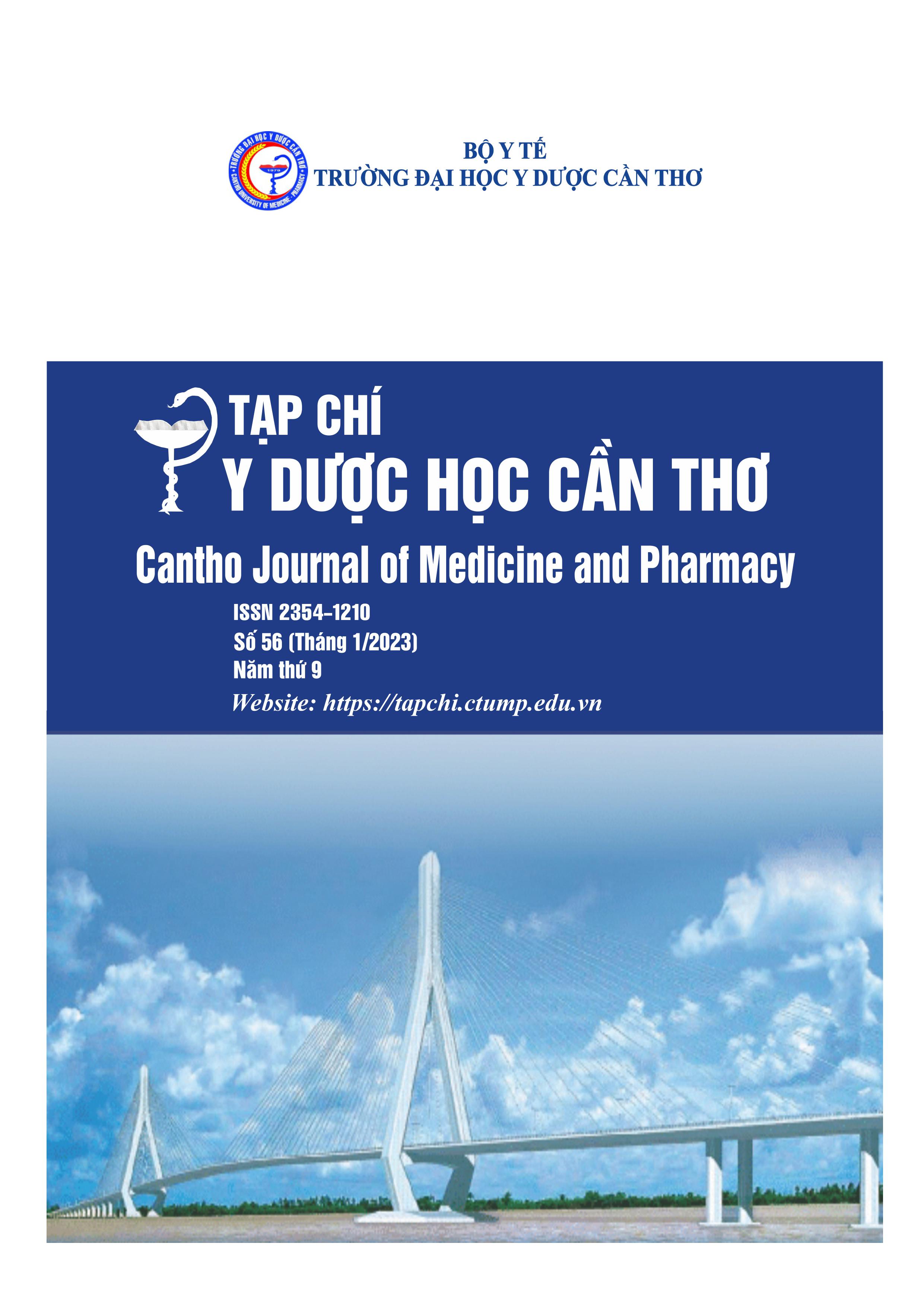EFFECTIVENESS OF LOW-LEVEL LASER THERAPY IN TREATMENT OF DENTIN HYPERSENSITIVITY ON PREMOLARS AND MOLARS
Main Article Content
Abstract
Background: Tooth sensitivity or dentin hypersensitivity is a common oral issue that is easily diagnosed but difficult to treat thoroughly. Currently, there have been many methods to treat dentin hypersensitivity, in which using low-level laser therapy is a new method with many advantages and needs to be studied more. Objectives: This study aims to determine clinical features, relative risk factors and evaluate the treatment effectiveness of low-level laser therapy for patients with tooth sensitivity on premolar and molar teeth. Materials and methods: A sample 101 patients >= 18 years old with 236 premolars and molars were divided into 2 treatment groups (n=118 each): group I (810nm diode laser, 0.5W) and group II (GC Tooth Mousse cream) from January 2021 to June 2022 at Can Tho University of Medicine and Pharmacy Hospital, sensitivity was assessed by evaporative stimulus. Results: The mean age was 33.35±13.5 years old. The prevalence of female was 57.4%, male was 42.6%, most sensitive position was in the cervical (98.3%), the most common triggering factor for tooth sensitivity was cold stimulation (88.1%), horizontal brushing (81.2%) was the main risk factor associated with tooth sensitivity. In both groups, there were effective reductions in tooth sensitivity at the immediate time and 3 months after treatment (p<0.001). There was no statistically significant difference in the effectiveness of reducing tooth sensitivity of group I and group II at 3 months after treatment (VAS score: 2.72± 2.31 and 3± 2.1, p=0.14). The treatment success rate of group I was 70.4% immediately and 78% after 3 months. Conclusion: Adults who have a habit of brushing their teeth horizontally are more prone to tooth sensitivity, especially in the cervical. Low-level laser therapy (810nm, 0.5W) effectively reduces tooth sensitivity immediately and after 3 months.
Article Details
Keywords
Tooth sensitivity, Dentin hypersensitivity, Low-level laser therapy, Laser diode
References
2. Bartlett DW, Shah P (2006), “Critical review of non-carious cervical (wear) lesions and the role of abfraction, erosion, and abrasion”, Journal of Dental Research, 85, pp. 306–12.
3. Clayton DR, McCarthy D, Gillam DG (2002), “A study of the prevalence and distribution of dentine sensitivity in a population of 17-58-year-old servingpersonnel on an RAF base in the Midlands”, Journal of Oral Rehabilitation, 29, pp. 14–23.
4. Davari Ar, Ataei E, Assarzadeh H (2013), “Dentin Hypersensitivity: Etiology, Diagnosis and Treatment; A Literature Review”, journal of Shiraz University Medical Sciences, 14(3), pp. 136-145.
5. Dilsiz A, Canakci V, Ozdemir A (2009), “Clinical evaluation of Nd: YAG and 685 nm diode laser therapy for desensitization of teeth with gingival recession”, Photomedicine and Laser Surgery, 27(6), pp. 843-848.
6. Grover V, Kumar A, et al. (2022), “ISP Good Clinical Practice Recommendations for the management of Dentin Hypersensitivity”, Journal of Indian Society of Periodontology, 26(4), pp. 307–333.
7. Haneet RK, Vandana LK (2016), “Prevalence of dentinal hypersensitivity and study of associated factors: a cross-sectional study based on the general dental population of Davangere, Karnataka, India”, International Dental Journal, 66(1), pp. 49–57.
8. Holland GR, Narhi MN, Addy M, Gangarosa L, Orchardson R (1997), “Guidelines for the design and conduct of clinical trials on dentine hypersensitivity”, Journal of Clinical Periodontology, 24 (11), pp. 808–13.
9. Favaro ZL, Soares PV, Cunha-Cruz J (2019), “Prevalence of dentin hypersensitivity: Systematic review and meta-analysis”, Journal of Dentistry, 81, pp. 1-6.
10. Liang X et al (2017), “Prevalence of dentin hypersensitivity among the residents of Xi'an city, China”, Acta Odontologica Scandinavica, 75(6), pp. 387-393.
11. Ricarte JM, Matoses VF, Llácer VJF (2008), “Dentinal sensitivity: concept and methodology for its objective evalution”, Medicina Oral Patologia Oral y Cirugia Bucal, 13(3), pp. 201-206.
12. Rosaiah K, Aruna K (2011), “Clinical Efficacy of Amorphous Calcium Phosphate, G.C. Tooth Mousse and Gluma Desensitizer in Treating Dentin Hypersensitivity”, International journal of dental clinics, 3 (1), pp. 1-4.
13. Tailor A, Shenoy N, Thomas B (2014), “To compare and evaluate the efficacy of bifluorid 12, diode laser and their combined effect in treatment of dentinal hypersensitivity- a clinical study”, Journal of Health Science, 4(2), pp. 54-58.
14. Wang Y, Que K, Lin L, Hu D, Li X (2012), "The prevalence of dentine hypersensitivity in the general population in China”, Journal of Oral Rehabilitation, 39(11), pp. 812-820.
15. Xia Y, Yang Z, Li Y, Zhou Z (2020), “The Effects of a Toothpaste Containing the Active Ingredients of Galla chinensis and Sodium Fluoride on Dentin Hypersensitivity and Sealing of Dentinal Tubules: An In Vitro Study and an Eight-Week Clinical Study in 98 Patients”, Medical


